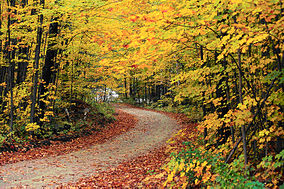Green Mountain National Forest
| Green Mountain National Forest | |
|---|---|
 | |
 | |
| Location | Vermont, United States |
| Nearest city | Rutland |
| Coordinates | 43°57′N 73°04′W / 43.950°N 73.067°W / 43.950; -73.067Coordinates: 43°57′N 73°04′W / 43.950°N 73.067°W / 43.950; -73.067 |
| Area | 399,151 acres (1,615.31 km2)[1] |
| Established | April 25, 1932[2] |
| Governing body | U.S. Forest Service |
| Website | Green Mountain & Finger Lakes National Forests |

Map of Green Mountain National Forest
Green Mountain National Forest is a national forest located in Vermont, a forest area typical of the New England/Acadian forests ecoregion. The forest supports a variety of wildlife, including beaver, moose, coyote, black bear, and white tailed deer. It also supports an abundant variety of bird species, such as wild turkey and ruffed grouse. The forest, being situated in Vermont's Green Mountains, has been referred to as the 'granite backbone' of the state.
The forest was established in 1932, as a result of uncontrolled overlogging, fire and flooding.[3] It consists of 399,151 acres (1,615.31 km2); and is the biggest contiguous land mass in the state. If Finger Lakes National Forest, which is managed as a unit of the Green Mountain National Forest, is included within it, GMNF is one of only two national forest northeast of the Pennsylvania-New Jersey border; the other being the White Mountain National Forest. Split into the southwest and central areas, GMNF has a total of eight wilderness areas. These were designated by Congress beginning with the Wilderness Act of 1964 to be areas off limits to mechanized gear down to and including bicycles.
In descending order of land area it is located in parts of Bennington, Addison, Rutland, Windham, Windsor, and Washington counties. The forest headquarters are in Rutland, Vermont, alongside those of Finger Lakes National Forest in New York.[4]
The forest contains three nationally designated trails, including parts of the Appalachian Trail and the Long Trail, as well as the Robert Frost National Recreation Trail. In addition, the forest also includes three alpine ski areas, seven Nordic ski areas, and approximately 900 miles of multiple-use trails for hiking, cross country skiing, snowmobiling, horseback riding, and bicycling.[5]
The forest benefitted from the American Reinvestment and Recovery Act (ARRA) of 2008. More typical forest revenue might come from Recreation fees (such as Mt Snow, Stratton and Bromley) and timber sales. Some 429 acres were set for forest regeneration in 2009. The bulk of expenditures might go towards road construction, recreation/wilderness & heritage, and wildlife/fish management. Projects in the latter category might include: land/water modification in support of ruffed grouse, wild turkeys, bear, trout and salmon; Bicknell's thrush; and the plant Jacob's ladder. The emerald ash borer represent a vexing side result of the global economy and a close threat to Vermont's trees.
Contents
1 Wilderness areas
2 Gallery
3 See also
4 References
5 External links
Wilderness areas
There are eight officially designated wilderness areas lying within Green Mountain National Forest that are part of the National Wilderness Preservation System.
- Big Branch Wilderness
- Breadloaf Wilderness
- Bristol Cliffs Wilderness
- George D. Aiken Wilderness
- Glastenbury Wilderness
- Joseph Battell Wilderness
- Lye Brook Wilderness
- Peru Peak Wilderness
Gallery
Frog
Little Rock Pond
Mushroom
Waterfall
See also
- Mount Snow
- New England/Acadian forests
- Temperate broadleaf and mixed forest
References
^ "Land Areas of the National Forest System" (PDF). U.S. Forest Service. January 2012. Retrieved June 30, 2012..mw-parser-output cite.citationfont-style:inherit.mw-parser-output qquotes:"""""""'""'".mw-parser-output code.cs1-codecolor:inherit;background:inherit;border:inherit;padding:inherit.mw-parser-output .cs1-lock-free abackground:url("//upload.wikimedia.org/wikipedia/commons/thumb/6/65/Lock-green.svg/9px-Lock-green.svg.png")no-repeat;background-position:right .1em center.mw-parser-output .cs1-lock-limited a,.mw-parser-output .cs1-lock-registration abackground:url("//upload.wikimedia.org/wikipedia/commons/thumb/d/d6/Lock-gray-alt-2.svg/9px-Lock-gray-alt-2.svg.png")no-repeat;background-position:right .1em center.mw-parser-output .cs1-lock-subscription abackground:url("//upload.wikimedia.org/wikipedia/commons/thumb/a/aa/Lock-red-alt-2.svg/9px-Lock-red-alt-2.svg.png")no-repeat;background-position:right .1em center.mw-parser-output .cs1-subscription,.mw-parser-output .cs1-registrationcolor:#555.mw-parser-output .cs1-subscription span,.mw-parser-output .cs1-registration spanborder-bottom:1px dotted;cursor:help.mw-parser-output .cs1-hidden-errordisplay:none;font-size:100%.mw-parser-output .cs1-visible-errorfont-size:100%.mw-parser-output .cs1-subscription,.mw-parser-output .cs1-registration,.mw-parser-output .cs1-formatfont-size:95%.mw-parser-output .cs1-kern-left,.mw-parser-output .cs1-kern-wl-leftpadding-left:0.2em.mw-parser-output .cs1-kern-right,.mw-parser-output .cs1-kern-wl-rightpadding-right:0.2em
^ "The National Forests of the United States" (PDF). ForestHistory.org. Archived from the original (PDF) on February 12, 2013. Retrieved July 30, 2012.
^ "Green Mountain and Finger Lakes National Forests". Outdoor.com. 2007-04-25. Retrieved 2011-03-12.
^ http://www.fs.fed.us/land/staff/lar/2007/TABLE_6.htm
^ http://www.fs.usda.gov/main/greenmountain/about-forest
External links
| Wikimedia Commons has media related to Green Mountain National Forest. |
- Official website




